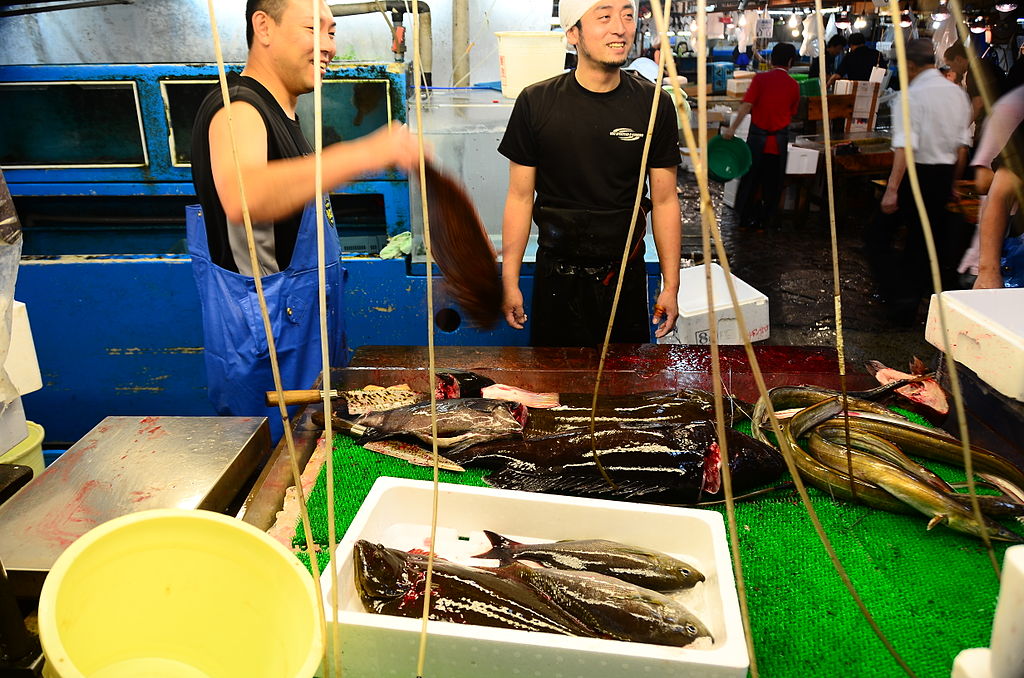Tsukiji Market (築地市場) is a large wholesale market for fish, fruits and vegetables in central Tokyo. It is the most famous of over ten wholesale markets that handle the distribution of fish, meat, produce and flowers in Tokyo. Tsukiji Market is best known as one of the world's largest fish markets, handling over 2,000 tons of marine products per day. It is scheduled to move to a new site in Toyosu in November 2016.
The sight of the many kinds of fresh fish and other seafood and the busy atmosphere of scooters, trucks, sellers and buyers hurrying around, make Tsukiji Market a major tourist attractions. In fact, the numbers of visitors have increased so much over recent years, that they have become a problem to the course of business, as the aging market's infrastructure was not anticipated to serve as a tourist spot.
Tuna Auction
The number of visitors to the tuna auction is limited to 120 per day, the maximum number which the market's infrastructure can accommodate. Tourists, who wish to see the auction, have to apply at the Osakana Fukyu Center (Fish Information Center) at the Kachidoki Gate, starting from 5:00am on a first-come, first-serve basis (may start earlier on busy days). A first group of 60 visitors will be admitted to the auction between 5:25 and 5:50, while a second group of 60 visitors will be admitted between 5:50 and 6:15.
Visitors usually start lining up long before 5am, and the maximum number is likely to be exceeded, in which case later arriving visitors will not be able to see the auction. Successful applicants will be able to view the auction from a designated visitor area. It is not allowed to view the auction from anywhere else or to use flash photography or to interfere with the business action in any other way
Photos:
"Tsukiji fish market - fishermen 01" by Dariusz Jemielniak ("Pundit") - Own work. Licensed under CC BY-SA 4.0 via Commons - https://commons.wikimedia.org/wiki/File:Tsukiji_fish_market_-_fishermen_01.jpg#/media/File:Tsukiji_fish_market_-_fishermen_01.jpg
"Tsukiji as seen from Shiodome" by Chris 73 / Wikimedia Commons. Licensed under CC BY-SA 3.0 via Commons - https://commons.wikimedia.org/wiki/File:Tsukiji_as_seen_from_Shiodome.jpg#/media/File:Tsukiji_as_seen_from_Shiodome.jpg
"Tsukiji Fresh Tuna Auction" by The original uploader was Cafe Nervosa at English Wikipedia - Transferred from en.wikipedia to Commons by Shizhao using CommonsHelper.. Licensed under CC BY-SA 2.5 via Commons - https://commons.wikimedia.org/wiki/File:Tsukiji_Fresh_Tuna_Auction.JPG#/media/File:Tsukiji_Fresh_Tuna_Auction.JPG
"Auction Tsukiji fishmarket" by Chris 73 / Wikimedia Commons. Licensed under CC BY-SA 3.0 via Commons - https://commons.wikimedia.org/wiki/File:Auction_Tsukiji_fishmarket.jpg#/media/File:Auction_Tsukiji_fishmarket.jpg





















































